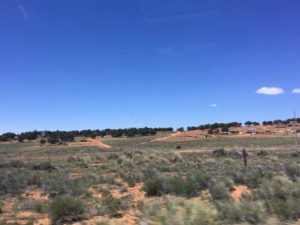
After spending about a month running through hot, dry deserts, slot canyons, and a dirty devil of a river full of quicksand, it was thrilling to arrive at our hostess’s home on the Hopi Nation. We had to park the van a little less than a mile away from where we would be lingering for a few days. This gave us an opportunity to do a little hike with our packs out to our campsite. As we got closer, it got greener and greener — something that was very shocking after seeing minimal amounts of vegetation for as long as we had. At our temporary home, there was a spring — a rock from where the water is coming from and trickling down into the canyon. This caused the soil to be more fertile, and for the vegetation to be perked up happily with green.
At the vibrant site there was a cute post-apocalyptic looking white patio, a small clearing shaped by raggedy shelves holding kitchen supplies, gardening tools, and a porcupine that would tramp around and jangle jars around as we listened to stories around the campfire. We would make a fire everyday which we would use to boil water, cook food, and warm us into the evening.
Our hostess, a member of the Hopi Nation, told us stories that informed us of the lessons of the cultural resilience of the Hopi people. Cultural resilience is hard to define. Most immediately, I am drawn to say that it is the ability of a culture to persist and maintain itself. However, this definition immediately creates issues in my mind. There are indigenous cultures that were wiped out by European colonists, for example, the Tainos of Puerto Rico. When the Spanish arrived in the 1500’s, they attempted to convert them to Catholicism and mold them into a ‘civilized’ people according to their beliefs. This didn’t pan out. The Tainos didn’t take well to the Spanish in many ways — in terms of health and civility. Many died due to illnesses brought over by the Spanish, but also due to the Spanish murdering and raping them as the Tainos attempted to protect themselves and their culture from the invaders.
As our hostess told the story of the Spanish arriving in Hopi lands, I realized I already knew the story since the Spanish attempted to do the same to the Hopi, but failed. This brought me to the question of why were the Hopi more resilient than the Tainos? One reason is their geography. The Hopi traveled long and far to find the springs at which they eventually arrived, one of which being the one we were residing at. Although the spring was there, the land where the Hopi lived and continue to live is extremely arid. This makes it difficult for a person to sustain themselves there, although the Hopi learned how to live off the land with various kinds of red, blue, and black corn and native plants and their unique planting techniques. We were taught how to plant blue corn, which includes digging a deep hole in the ground and planting a seed in the spring. These seeds will begin to sprout after the process of dryness and monsoons passes over, giving the seeds the unique amounts of precipitation necessary so they grow into cobs, which then the Hopi will dig out. The Spanish were not privy to the agricultural techniques needed to survive there, and were weakened by this. On the other hand, Puerto Rico is much more arable and easier for a European to come over and learn to live off the land, which allowed the Spanish to remain strong and overpower the Tainos. The Hopi resisted the Spanish similarly, but managed to be enough of a threat that the Spanish didn’t exert their presence for too long, although held their claims on the land. This allowed the Hopi culture to persist. From this, it appears that the geography of the land can serve as a natural defense, and boost cultural resilience.
Overall, it was a great experience to go and hear stories and learn about a notion that was new to me — cultural resilience. Further, I enjoyed learning of the role of geography in cultural resilience. In the case of the Hopi, the land where they live protected them from outsiders, and allowed their culture to persist.